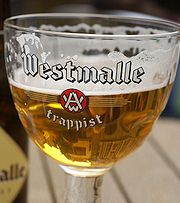
Tripel
Encyclopedia

Low Countries
The Low Countries are the historical lands around the low-lying delta of the Rhine, Scheldt, and Meuse rivers, including the modern countries of Belgium, the Netherlands, Luxembourg and parts of northern France and western Germany....
, some other European countries, and the USA to describe a strong pale ale, loosely in the style of Westmalle Tripel. The origin of the term is unknown, though the main theory is that it indicates strength in some way. It was used in 1956 by the Trappist brewery, Westmalle
Westmalle Brewery
Westmalle Brewery is a Belgian trappist brewery located in the Trappist Abbey of Westmalle. It produces three beers, which are designated trappist beer because they follow the rules of the International Trappist Association...
, to rename the strongest beer in their range, though both the term Tripel and the style of beer associated with the name (strong pale ale), were in existence before 1956. The style of Westmalle's Tripel and the name was widely copied by the breweries of Belgium, and in 1987 another Trappist brewery, the Koningshoeven
De Koningshoeven Brewery
De Koningshoeven Brewery is a Dutch Trappist brewery founded in 1884 within the walls of the abbey Onze Lieve Vrouw van Koningshoeven in Berkel-Enschot .- History :...
in the Netherlands, expanded their range with a beer called La Trappe Tripel, though they also produced a stronger beer they termed La Trappe Quadrupel
Quadrupel
Quadrupel is the brand name of a strong seasonal beer La Trappe Quadrupel brewed by De Koningshoeven Brewery in the Netherlands, the only Trappist brewing abbey not in Belgium...
. The term spread to the USA and other countries, and is applied by a range of secular brewers to a strong pale ale in the style of Westmalle Tripel.
History
The term Tripel comes from the Low CountriesLow Countries
The Low Countries are the historical lands around the low-lying delta of the Rhine, Scheldt, and Meuse rivers, including the modern countries of Belgium, the Netherlands, Luxembourg and parts of northern France and western Germany....
- that is the modern Netherlands
Netherlands
The Netherlands is a constituent country of the Kingdom of the Netherlands, located mainly in North-West Europe and with several islands in the Caribbean. Mainland Netherlands borders the North Sea to the north and west, Belgium to the south, and Germany to the east, and shares maritime borders...
and Belgium
Belgium
Belgium , officially the Kingdom of Belgium, is a federal state in Western Europe. It is a founding member of the European Union and hosts the EU's headquarters, and those of several other major international organisations such as NATO.Belgium is also a member of, or affiliated to, many...
; though the origin of the term is unknown. The two main theories are that it indicates strength, either by a series of marks, such as crosses, on a cask - X for the weakest strength, XX for medium strength, and XXX for the strongest beer, or by reference to the original gravity of a beer which roughly corresponds to 3% abv
ABV
ABV is a three-letter acronym that may refer to:* Alcohol by volume, a measure of the alcohol content of alcoholic drinks* Nnamdi Azikiwe International Airport, Abuja, Nigeria, from its IATA airport code...
, 6% abv and 9% abv. According to brewing historian Michael Jackson, the first golden strong pale ale associated with the term was brewed by Hendrik Verlinden of the Drie Linden (Three Lindens) brewery in the early 1930s, when ale brewers were looking to compete with the pale lagers from Plzeň. Verlinden had an association with the Trappist brewery, Westmalle, assisting them with brewing, and becoming the only secular brewer allowed to carry the Trappist Beer designation. The year after Verlinden produced a golden strong pale ale for his own brewery in 1932, the Witkap Pater (now known as Witkap Tripel, produced by the Slaghmuylder Brewery), Westmalle released a beer under the name Superbier. It was a strong blonde ale and was very likely based on a blonde beer the monks had been brewing sporadically since 1931. In 1956 they renamed it Tripel, and the popularity of that brand ensured the name is still strongly associated with the Westmalle brewery, though both the term Tripel and the style of beer associated with the name (strong pale ale), were in existence before 1956. In 1956, the recipe was modified by Brother Thomas, the head brewer of Westmalle, by the addition of more hops, and it then took on the name Tripel, it has remained essentially unchanged since.
Tim Webb in his Good Beer Guide to Belgium says that some of the pre-1956 beers called Tripel were dark, in contrast to the modern understanding of the term.

